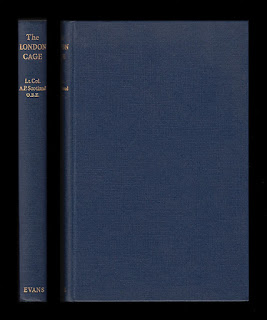The Book
The London Cage; Lt. Col. A.P. Scotland, O.B.E.; Evans Brothers Limited; London; 1957.
Summary

I purchased a copy of The London Cage several years ago and got around to reading it this past week.
The London Cage was one of a series of interrogation centres run by MI19. It was commanded by Lt. Col. A.P. Scotland. After the war, Scotland wrote the story of the London Cage but ran afoul of the Official Secrets Act. His original manuscript apparently outlined many of the controversial methods he used to extract confessions from the prisoners of war who passed through his hands. After being sanitized, the book was published in 1957.
Scotland outlines how he became involved in intelligence work in South Africa, even to the point of serving in the German Army for four years. We learn of his derring-do during World War I when he crossed enemy lines and sniffed out information on the Germans. Much of the book deals with the aftermath of World War 2 and how Scotland and his group sought to extract confessions from suspected war criminals. Given the sanitized nature of the London Cage’s interrogation methods, there is actually very little information on the Cage. Scotland spends a fair bit of time outlining the war crimes that took place – the mass murder of Allied troops at Paradis, the execution of 50 Stalag Luft III escapees, and the execution of Italians by the Germans in retaliation for a partisan attack.

While Scotland acknowledges that many of the Nazi war criminals claimed torture at his hands, he denies that any took place. Interesting, given the fact that he had initially included so many of the methods in his initial draft. One thing Scotland lamented was that he, as an Intelligence Officer, had been called upon to testify at the war crimes tribunals. He was thereby subjected to questions, harassment, accusations and cross-examination, something he felt no Intelligence Officer should have to undergo. In that respect, the officers at MI5s secret interrogation centre, Camp 020, had an easier time of it, for none of them were ever called to testify at the German spy trials. In fact, the officers of MI5 would do anything to avoid being called by the courts, even to the point of dropping charges against at least one suspect.
Review
The book was definitely readable and interesting. I learned quite a bit about some of the war crimes committed against Allied troops by the Germans. I didn’t learn a lot about the London Cage, however, and that is disappointing.
This article by The Guardian has a nice summary of the saga concerning Scotland’s book.
Several War Office files at The National Archives relate to the publication of Scotland’s book.
N.B. I read Helen Fry’s book The London Cage.
Feature Image – 8 and 8a Kensington Palace Gardens in 1938, before they became used as the London Cage.
